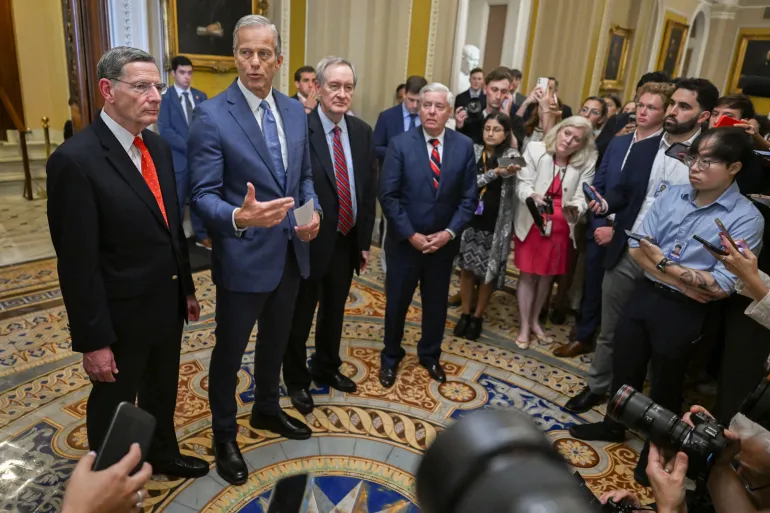The new US Budget Plan 2025 is creating quite a buzz — from Washington D.C. to Wall Street and even kitchen tables across America. But why is everyone talking about it?
Simply put, this year’s budget isn’t just about government spending. It’s about the economy’s direction, potential tax changes, and how federal priorities could impact ordinary Americans — from healthcare to education and business growth.
In this blog, we’ll break down what’s inside the US Budget Plan 2025, what’s changing, and what it could mean for your daily life and finances — without the jargon.

Understanding the New US Budget Plan 2025
What the Budget Plan Represents
Every year, the federal budget outlines how the government plans to collect and spend money. The US Budget Plan 2025 goes a step further — it reflects the administration’s long-term economic vision for the country.
According to Bloomberg, the 2025 budget emphasizes fiscal responsibility while balancing investments in social programs, infrastructure, and national defense.
In short, it’s about finding a middle ground between stimulating growth and reducing the national deficit.
Key Highlights of the US Budget Plan 2025
Focus on Middle-Class Tax Relief
One of the most discussed features is tax relief for middle-income earners. The administration aims to reduce pressure on working families while ensuring corporations pay their fair share.
For example, childcare credits, earned income tax credits, and education incentives are expected to increase.
Meanwhile, high earners may see slightly higher tax rates, aligning with the government’s goal to make taxation more equitable.
Investment in Clean Energy and Infrastructure
The 2025 plan allocates billions toward renewable energy, electric vehicle infrastructure, and green technology.
This isn’t just about climate goals — it’s also about job creation and energy independence. As CNBC reports, federal support for clean industries could spark a wave of private investment, particularly in states leading the green transition.
Healthcare and Education Reforms
Healthcare remains one of the largest portions of the federal budget. The plan proposes expanding Medicaid and strengthening the Affordable Care Act to make coverage more affordable.
Education also sees a boost — especially in early childhood education, public school funding, and student loan reforms. The administration hopes these steps will help reduce inequality and prepare a stronger workforce for the future.
The Economic Impact of the Budget Plan 2025
Growth vs. Inflation Debate
Critics argue that high spending could reignite inflation. However, supporters believe that targeted investments will strengthen long-term growth.
The Federal Reserve’s stance will be crucial here. If the economy shows signs of overheating, the Fed may adjust interest rates to balance growth and inflation — something closely watched by economists and markets alike. You can explore the Fed’s latest outlook on FederalReserve.gov.
Impact on Jobs and Wages
With major investments in manufacturing, green jobs, and public works, the US Budget Plan 2025 could create thousands of new positions.
Higher demand for skilled labor may also push wages upward — good news for workers, though it might pressure small businesses with rising costs.
Still, if productivity rises alongside wages, the net effect could strengthen America’s middle class.
What the US Budget Plan 2025 Means for You
For Workers
Expect more incentives for training and job transition programs. If you’re in a sector like construction, renewable energy, or healthcare, you may benefit from new government-backed opportunities.
For Small Businesses
Small businesses could see better access to loans and tax deductions, particularly for adopting clean energy solutions or creating local jobs. The Small Business Administration (SBA) may expand its financing programs to support these efforts.
For Homeowners and Consumers
If inflation continues to cool and the budget stabilizes the economy, consumers could benefit from lower borrowing costs and stable interest rates.
Additionally, homeowners investing in energy-efficient upgrades might qualify for federal tax credits under new sustainability programs.

Political Reactions and Public Opinion
Not surprisingly, the US Budget Plan 2025 has become a hot political topic.
- Supporters call it a visionary plan that prioritizes growth, fairness, and sustainability.
- Critics warn that it could lead to overspending and higher national debt.
As CNN reports, debates in Congress are already heated, with lawmakers divided over defense funding, tax increases, and climate initiatives.
Public opinion, however, seems cautiously optimistic — especially among younger voters who prioritize environmental action and education reform.
What Happens Next?
After the proposal, the budget goes through Congressional review and negotiations. Amendments are likely before the final version is approved.
The process may take months, but once passed, the 2025 budget will set the tone for America’s economic direction for years to come.
Final Thoughts
The reason everyone’s talking about the new US Budget Plan 2025 is simple: it’s not just about numbers — it’s about priorities, fairness, and the nation’s economic future.
Whether you’re a worker, business owner, student, or retiree, this plan could affect your taxes, job opportunities, and cost of living in ways that truly matter.
As the debates continue, staying informed will help you understand how these changes might shape your financial outlook in 2025 and beyond.
FAQs About the New US Budget Plan 2025
Q1: What is the main goal of the US Budget Plan 2025?
The main goal is to balance fiscal responsibility with long-term growth — focusing on tax fairness, clean energy, and expanding access to healthcare and education.
Q2: How does the US Budget Plan 2025 affect middle-class Americans?
It aims to lower tax burdens, increase job opportunities, and provide more affordable healthcare and education benefits for working families.
Q3: When will the new US Budget Plan 2025 take effect?
Once Congress approves it, most changes will roll out at the start of the federal fiscal year, beginning October 1, 2025.